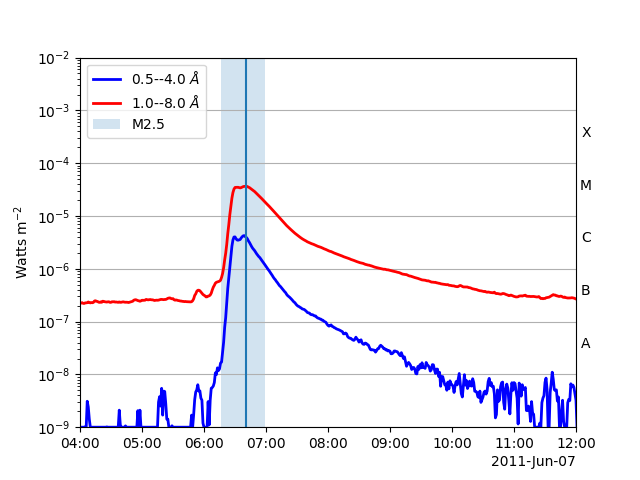Note
Go to the end to download the full example code
Flare times on a GOES XRS plot#
How to plot flare times as provided by the HEK on a GOES XRS plot.
import matplotlib.pyplot as plt
from sunpy.net import Fido
from sunpy.net import attrs as a
from sunpy.time import parse_time
from sunpy.timeseries import TimeSeries
Let’s grab GOES XRS data for a particular time of interest and the HEK flare data for this time from the NOAA Space Weather Prediction Center (SWPC). Here we are searching for data from the GOES-15 satellite and for the 1-min average time-sampled data.
tr = a.Time('2011-06-07 04:00', '2011-06-07 12:00')
results = Fido.search(tr, a.Instrument.xrs & a.goes.SatelliteNumber(15) & a.Resolution("avg1m") | a.hek.FL & (a.hek.FRM.Name == 'SWPC'))
Then download the XRS data and load it into a TimeSeries.
Next let’s retrieve HEKTable from the Fido result
and then load the first row from HEK results into flares_hek.
hek_results = results['hek']
flares_hek = hek_results[0]
Lets plot everything together.
fig, ax = plt.subplots()
goes.plot(axes=ax)
ax.axvline(parse_time(flares_hek['event_peaktime']).datetime)
ax.axvspan(
parse_time(flares_hek['event_starttime']).datetime,
parse_time(flares_hek['event_endtime']).datetime,
alpha=0.2, label=flares_hek['fl_goescls']
)
ax.legend(loc=2)
ax.set_yscale('log')
ax.set_xlim(tr.start.to_datetime(), tr.end.to_datetime())
plt.show()

Total running time of the script: (0 minutes 3.173 seconds)